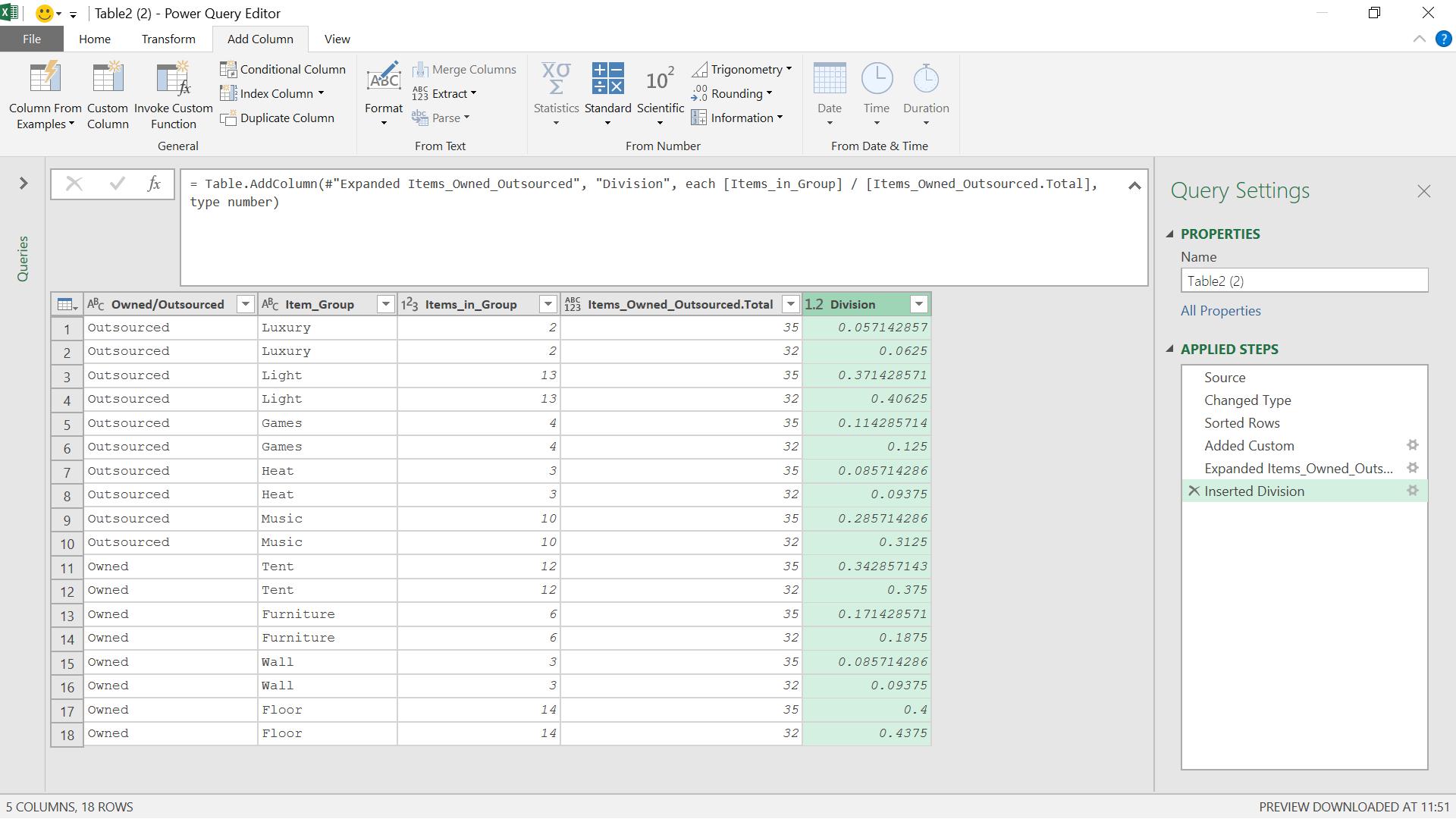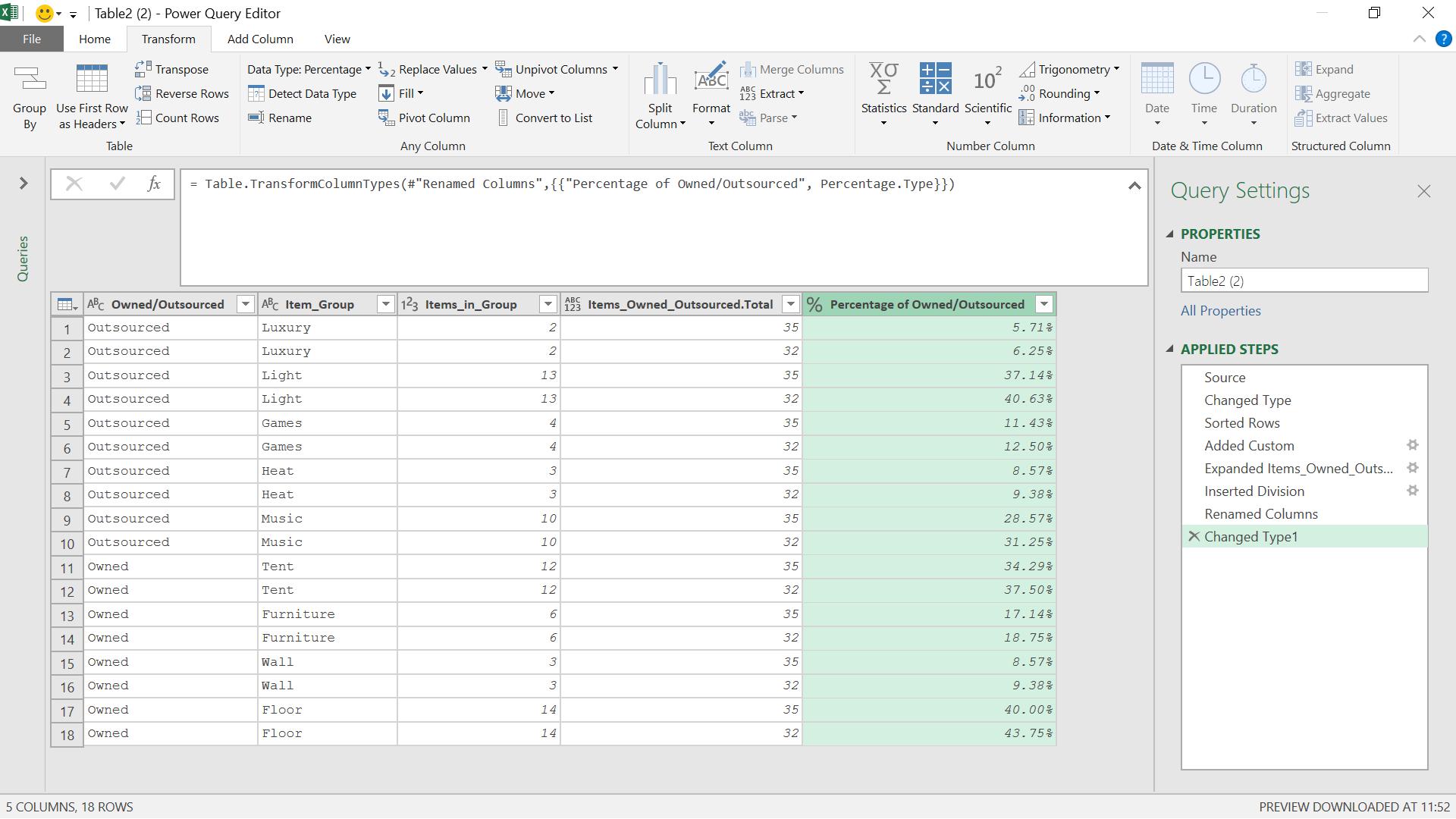Power Query: Group Dynamics
10 October 2018
Welcome to our Power Query blog. This week, I look at how to calculate a group share.
This week’s blog looks at how to achieve a group share calculation in Power Query, in the same way that I can perform one in Excel. This is an exercise in how to manipulate data in Power Query; it is not how I would actually attempt to do this calculation, since it is much easier to do this in Excel or PowerPivot
I have the following data. I am interested in finding out which groups make up most owned items. I want to see the percentage of owned or outsourced items for each group.

In Excel I can create an additional column and enter the formula
=[@[Items_in_Group]]/SUMIFS([Items_in_Group],[Owned/Outsourced],[@[Owned/Outsourced]])
which calculates the percentage of outsourced or owned items that are in the current group.

I can see that ‘Floor’ items make up 40% of the owned items.
I want to perform the same calculation in Power Query, so I create a new query ‘From Table’ from the ‘Get & Transform’ section on the ‘Data’ tab.

I start by grouping by my Owned/Outsourced column. This will allow me to make my first step - to calculate the total number of items in each group:

I use a basic group by statement, where I sum Items_In_Group. This will simplify my data so that I can see the number of items Owned and Outsourced.

I know that step ‘Changed Type’ shows me all the details, and ‘Grouped Rows’ shows me the total items owned and outsourced. One method I can use to get to my final calculation is to merge these steps by merging ‘Table2’ with itself (I will show another method later).

I choose the first column each time, and select the left outer join.

From the M code generated for this step, I can see that the ‘Grouped Rows’ step has been merged with itself.
= Table.NestedJoin(#"Grouped Rows",{"Owned/Outsourced"},#"Grouped Rows",{"Owned/Outsourced"},"Grouped Rows",JoinKind.LeftOuter)
I can edit this step so that I merge the ‘Changed Type’ step instead.

I have now taken my ‘Changed Type’ step with all the details and merged the ‘Grouped Rows’ step. I only want Total Items Owned or Outsourced from the ‘Grouped Rows’ step, so I expand the table and pick this column.

As usual, I don’t want to ‘Use original column name as prefix’!

Now I have the two key values for my percentage calculation, I can create a custom column from the ‘Add Column’ tab.

I divide the number of items in the group by the items owned or outsourced to see which group is mostly made up of owned and outsourced items respectively. I could also do this using the ‘Divide’ option from the ‘Standard’ part of the ‘From Number’ section.

In the same way I did for the Excel method, I convert my new column to type ‘Percentage’.

My calculations are consistent with the Excel method.
I can achieve the same result in another way. I can use M code if I don’t want to merge my queries. Instead of using the ‘Grouped Rows’ step above, I create a custom column which will carry out the grouping for me.

The M code I have used is:
= Table.AddColumn(#"Sorted Rows", "Items_Owned_Outsourced", each Table.Group(Table2, "Owned/Outsourced", {"Total", each List.Sum([Items_in_Group])}))
The part of this which creates my grouped total is Table.Group(Table2, "Owned/Outsourced", {"Total", each List.Sum([Items_in_Group])})
I have grouped by Owned/Outsourced and summed Items_in_Group within this. This gives me a table very similar to the one created by the merging of the query with itself, which I can expand.

As before, I can create my custom (or divide) column and convert it to a percentage. This time, I will use the divide functionality.

This gives me a new Division column which I can rename.

Having converted this to the right data type, my data is consistent with the other results.

Come back next time for more ways to use Power Query!

